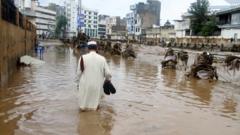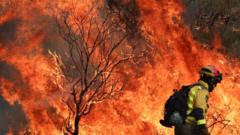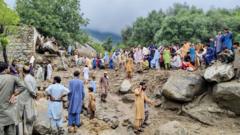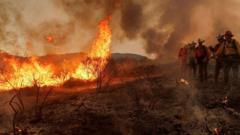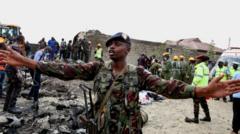Over 200 individuals remain unaccounted for in Buner district, northwest Pakistan, following catastrophic flooding and landslides, an official reported. As current rescue operations continue, the death toll from the recent flash floods has tragically exceeded 300 across Pakistan and its administered Kashmir. Most casualties have been noted in the mountainous region of Khyber Pakhtunkhwa province. Jehangir Khan, a spokesman for the deputy commissioner of Buner, stated that at least 209 people are still missing, a figure that could worsen as rescue teams manage recovery efforts.
**Over 200 People Still Missing in Pakistan's Flood Disaster Amid Ongoing Emergency Efforts**
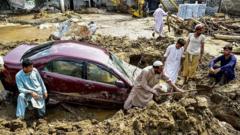
**Over 200 People Still Missing in Pakistan's Flood Disaster Amid Ongoing Emergency Efforts**
The aftermath of devastating floods in north-west Pakistan leaves hundreds unaccounted for, as rescue teams race against time.
Reports indicate that local teams have had to bury eight unclaimed bodies due to the unavailability of family members for identification, primarily attributed to severely damaged access roads. The provincial disaster management authority's head, Asfandyar Khattak, also confirmed multiple missing persons in the Shangla district.
Monsoon rains typically account for approximately 75% of South Asia's annual precipitation, and these floods are exacerbated by climate change, leading to increased frequency and intensity of related weather phenomena. Alongside areas in Pakistan, torrential rains have also affected Indian-administered Kashmir, where flash floods have already claimed over 60 lives.
Meanwhile, authorities continue to forecast heavy rainfall in north-west Pakistan until August 21, intensifying the recovery challenges in disaster-prone regions. Pakistan is contending with the severe impact of this year's monsoon season, which has resulted in at least 650 fatalities since June. The region, particularly Punjab, which houses about half of Pakistan's populace, has observed rainfall levels surging by 73% compared to the previous year, marking an alarming trend in hazardous weather patterns.
Researchers warn that climate change complicates these natural disasters, causing ground instability which can lead to landslides and disrupt river flow. While the precise catalysts behind the recent deluge are still under investigation, experts point to melting glaciers as a significant factor contributing to the current situation.
Monsoon rains typically account for approximately 75% of South Asia's annual precipitation, and these floods are exacerbated by climate change, leading to increased frequency and intensity of related weather phenomena. Alongside areas in Pakistan, torrential rains have also affected Indian-administered Kashmir, where flash floods have already claimed over 60 lives.
Meanwhile, authorities continue to forecast heavy rainfall in north-west Pakistan until August 21, intensifying the recovery challenges in disaster-prone regions. Pakistan is contending with the severe impact of this year's monsoon season, which has resulted in at least 650 fatalities since June. The region, particularly Punjab, which houses about half of Pakistan's populace, has observed rainfall levels surging by 73% compared to the previous year, marking an alarming trend in hazardous weather patterns.
Researchers warn that climate change complicates these natural disasters, causing ground instability which can lead to landslides and disrupt river flow. While the precise catalysts behind the recent deluge are still under investigation, experts point to melting glaciers as a significant factor contributing to the current situation.

